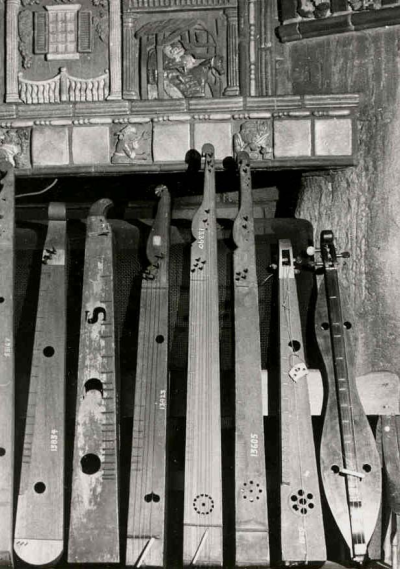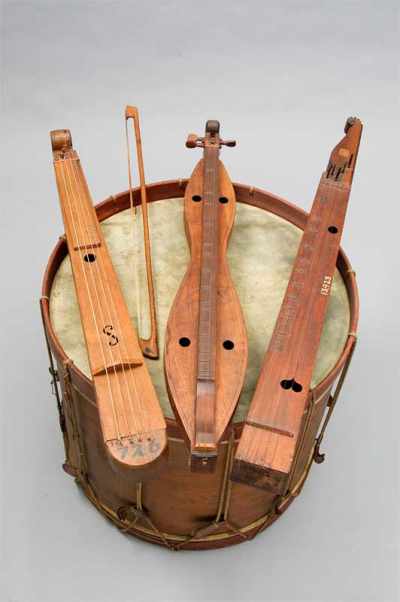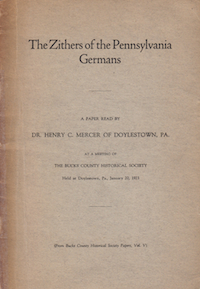The scheitholt, whose form is the predecessor to the modern alpine zither, was constructed and played in the US by early German immigrants in the 18th and 19th centuries. In 1923, Dr. Henry Mercer presented his research of numerous zithers, then museum pieces, to members of the Bucks Country Historical Society.

As Germans immigrated to America, they typically settled in areas where there were family members, established communities or areas that reminded them of their homeland. One such area that was heavily settled by German immigrants is Pennsylvania.
German immigrants brought their values, their religion, their preferences for food as well as their music. German music played during this period was often played on what is known as a zither. By the German immigrants who played and enjoyed them, they were known as "zitters". In Germany, the instrument was known as a scheitholt, which can be translated to "wooden stick" in English.

Mercer Museum zithers with Ed Thomas Kentucky dulcimer
Photo Courtesy Mercer Museum ©
Read by Dr. Henry Mercer before members of the Bucks County Historical Society in 1923, the paper "The Zithers of The Pennsylvania Germans" details the museum's collection of zithers, seven of them being plectrum zithers with the remainder being bowed zithers. Although the exact tuning of the zithers in the collection is unknown, their method of playing and construction could be discerned by examination and through interviews conducted with members of the community who could recall how the instruments were constructed and played. Materials for the instrument used a combination of hand-crafted and store-bought pieces. The plectrums used were crude and were either pieces of wood, bone or quills.
Although no conclusions are drawn as to the origin of the zithers, comparisons to other instruments are made and their similarities are accented. One such instrument discussed is the "Dulicimore", known today as the dulcimer. This instrument, played in remote mountain regions of Kentucky and Tennessee is similarly constructed and is played in the same manner, either bowed or plucked with plectrum, as the zithers being examined. Dr. Mercer suggests that it is possible that the instrument was brought over by the English immigrants who inhabited this area. When plucked, quills or plectrums made of leather were also used.
With the assistance of colleagues, a number of similarly constructed instruments were located in a museum in Friesland, Holland. Here they were known as a "Hommel" or "Nordische Balk" and were also played in the same manner, either plucked with a plectrum or bowed. In addition to Holland, Dr. Mercer asserts that the zither form could also be found in Russia, France and Italy, although they are known by different names.

Bowed zither, Ed Thomas Kentucky dulcimer and Plectrum zither
Photo Courtesy Mercer Museum ©
For those interested in the zither, the construction of early folk instruments and their expression within the community, "The Zithers of The Pennsylvania Germans" provides an interesting insight into the zither and the German immigrants of Pennsylvania. For the enjoyment of the zither community, Dr. Mercer's paper has been digitized and can now be downloaded by clicking on the download link below the following image. For additional reading materials pertaining to the zither, see the Reading page.

(Download)
About the Museum: The Mercer Museum is the legacy of archaeologist and historian Dr. Henry Mercer, whose work served to ensure the preservation of handmade, early American, artifacts for posterity. The Mercer Museum, one of Bucks County’s premier tourist attractions, offers visitors a unique window into pre-Industrial America as seen through the implements used in everyday life. The Museum’s collection includes more than 40,000 objects exhibiting the tools of more than 60 different crafts and trades, providing one of the world’s most comprehensive portraits of material culture in America. The museum is raising funds for a $10 million expansion and renovation program to expand changing exhibition space and visitor services, as well as enliven existing spaces within the museum. The Mercer Museum is located at 84 South Pine Street in Doylestown and is open for self-guided exploration 7 days a week.

Thank you to Jim Vorosmarti for contributing an original copy of Dr. Mercer's paper. It is this copy that has been digitized and shared on this page. To grow as a resource, Zither US is seeking your contributions. Do you have stories or experiences pertaining to the zither that you would like to share with the community? If so, email dave@zither.us, or use the provided contact form.
